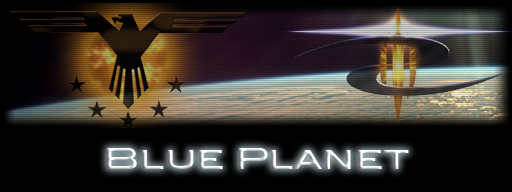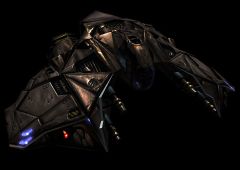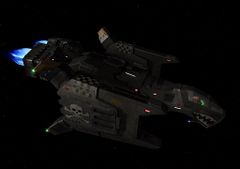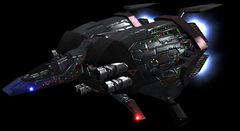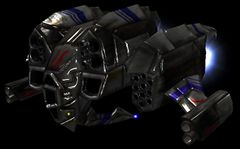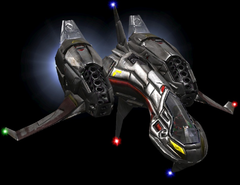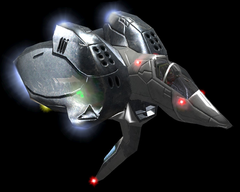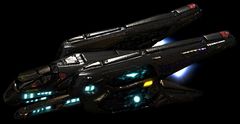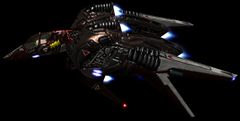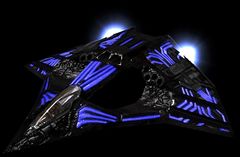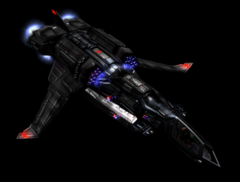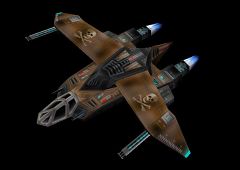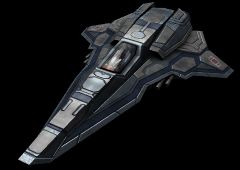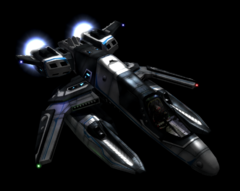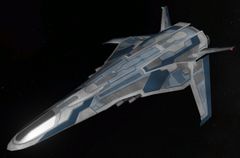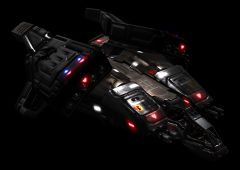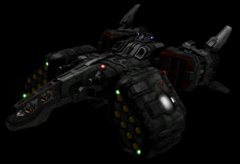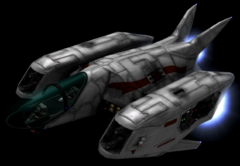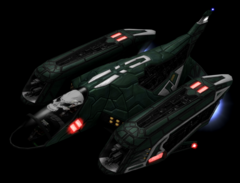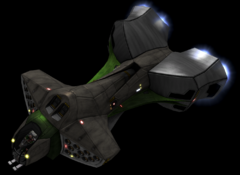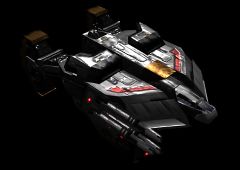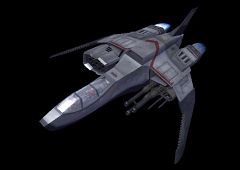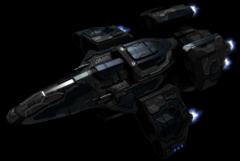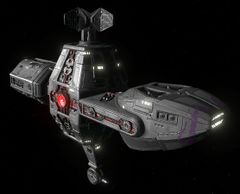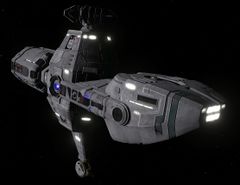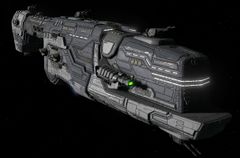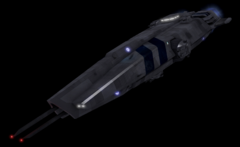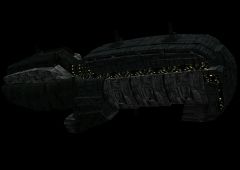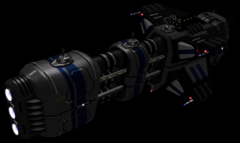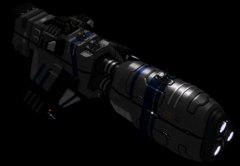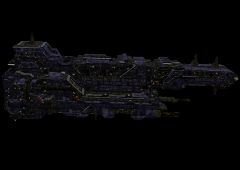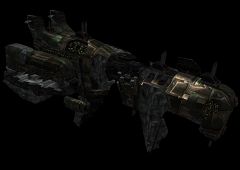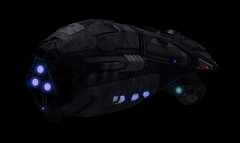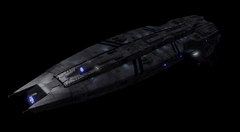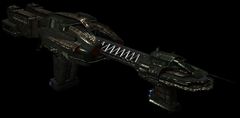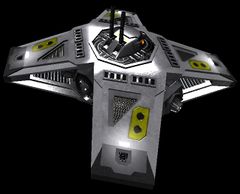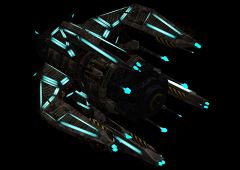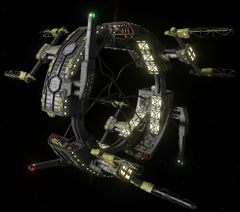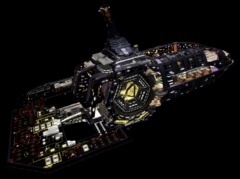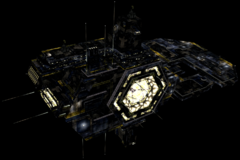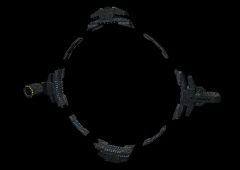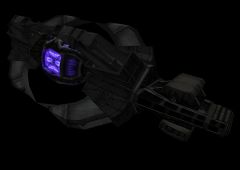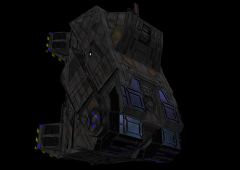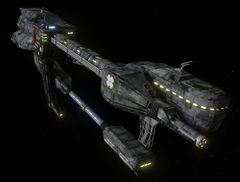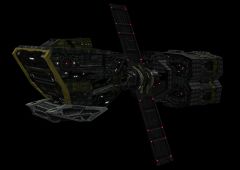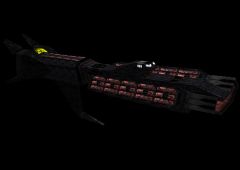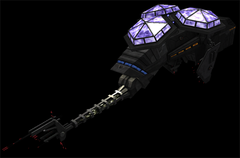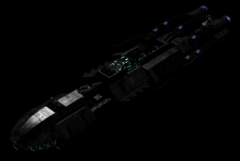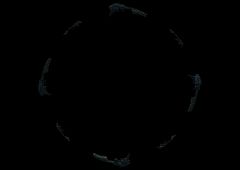Blue Planet ships data
| The following information has not been confirmed by Volition and is therefore not canon for the FreeSpace universe. |
|---|
This page aims to be a one-stop shop for tech room entries and veteran comments relating to BP ships.
Back to Blue Planet Tech Room data.
Contents
GTVA Terran ships
GTVA Terran fighters
GTF Ulysses
A product of joint Terran-Vasudan design, the Ulysses is a Great War-era light space superiority fighter renowned for its maneuverability and slim target profile. It saw limited action during the Second Shivan Incursion, serving on front-line units with the Neo-Terran Front and as a combat evaluation fighter with the GTVA. The Ulysses remains in very limited production, but has been completely retired from front-line GTVA formations.
GTF Loki
The linchpin of GTI fighter forces during Rybak's Hades Rebellion was the Loki stealth fighter. Initially an invisible nightmare, the Loki lost its main tactical advantage when a weakness in its stealth systems was discovered. It was moved into the role of scout fighter during Reconstruction, but was often pressed into the dogfight and intercept role by the Neo-Terran Front, where it earned praise for its agility but struggled to compensate for its structural weakness. The Loki has not been produced since the NTF Rebellion, and most remaining spaceframes have been sold off.
GTF Hercules
The Hercules assault fighter was the crowning jewel of Allied fighter forces during the Great War, and it remained a favorite amongst pilots even after the introduction of its successor, the Hercules II. Many Hercules units were lost during the NTF rebellion. The Hercules has been pulled from front-line service, and production has been discontinued. Remaining spaceframes serve as targets or in security operations.
GTF Myrmidon
The Myrmidon fighter, designed by RNI Systems to fulfill an impossibly broad request from the Admiralty, is a space superiority fighter with problematic handling, the primary firepower of an assault craft, and three secondary banks of unusual design and limited capacity. It is gradually being phased out, but still serves as a line fighter, bomber escort, and battle group guardian across the Terran elements of the Alliance fleet. Some pilots achieve a particular affinity with this unusual craft, but in general its wide target profile has given it a reputation as a pilot-killer. Captured Neo-Terran Front pilots reported that the Myrmidon was respected for its firepower but considered too clumsy for its role.
GTF Perseus
The mainstay of the Terran fleet after the Second Incursion, the Perseus is produced on nearly every world in the Alliance and assigned to every destroyer in every battle group. Reassigned from intercept to multirole combatant after its sterling performance during the Second Incursion, the Perseus is cheap, flexible, and an excellent dogfighter and interceptor. In a pinch it can perform anti-subsystem strikes on warships with Stiletto II bombs. Even with the advent of next-generation fighters, the Perseus will remain in service for years to come.
GTF Hercules Mark II
The Hercules II assault fighter sacrifices some of its predecessor's cannon firepower for a boost in secondary capacity. The modernized, hybrid spaceframe offers enhanced ordnance bays and a sophisticated fire control computer. The Hercules II performed well during its OpEval period and, despite casualties during the Second Shivan Incursion, was judged a success in its assigned role attacking lightly defended targets and cruisers. However, the introduction of the Ares spaceframe, a modified Hercules II, has limited Hercules II deployment in the true heavy assault role. Hercules II fighters are used as skirmishers against lightly defended convoys, and as heavy missile pickets on escort missions.
GTF Erinyes
The Erinyes had barely entered its OpEval period when the Second Shivan incursion began. It served with SOC units and, later, elite line squadrons, where it gained a reputation for massive firepower but low sustainability. Mounting the UD-8 Kayser probability weapon, the Erinyes' eight gun banks and good secondary capability give it tremendous killing power. But its reactor cannot handle the strain of sustained fire, and its maneuverability leaves something to be desired. Although it proved effective at massacring most Shivan fighters, and went into wide-scale production during the Threat Exigency Initiative, it remains an oddly paradoxical design - an excellent killer but a limited fighter. As agility became more and more critical to fighter design, the complex Erinyes proved impossible to re-engineer. Although it remains in service with elite squadrons for heavy space superiority missions, it will soon be superceded by the next-generation GTF Nyx.
GTF Ares
The Ares was the result of a crash program to rebuild the Hercules Mark 2 as a heavily armored missile boat. Slower and clumsier than its base model, the Ares mounts depleted uranium armor plating over critical subsystems, molybdenum plates, and enhanced shields. It can carry sufficient Trebuchet missiles to disarm a light warship or fend off multiple bomber wings before rearming. The Ares entered service just as the Shivans stormed Capella, and what few units were available saved thousands of lives during escort missions. Despite a stormy production history, the Ares is now a front-line combatant, used in heavy assault missions, pop-up Trebuchet strikes, and critical defensive missions. Despite its usefulness as a missile platform, it cannot dogfight effectively, and must avoid interceptors at all costs.
GTF Pegasus
The low-visibility, sensor-stealthed Pegasus fighter is a recon platform above all else. Operated primarily by Special Operations Command, Pegasus pilots work in pairs or alone, cruising for long cold hours or days without making telltale subspace jumps. The onboard sensor systems are adequate to the recon task, but limited by the need to maintain EMCON. Even when they must make subspace transits, Pegasus jump drives are difficult to detect or vector. Pegasus pilots gathered critical information that helped suppress brush wars after the Second Incursion, and allegedly performed deniable assassination missions.
GTF Aurora
The Aurora is a heavy reconnaissance fighter designed to replace the Loki in its intended role of scouting, interception and space superiority. The Aurora is a swift fighter and carries several advanced avionics and sensor systems to assist in the gathering of information. However, the added equipment has produced a heavy hull, limiting the combat manoeuverability of the design. Aurora fighters are currently undergoing mission trials with the 14th Battlegroup in the Sol system.
GTF Kulas
The GTF Kulas was originally a civilian design popular with pirates and law enforcement agencies within GTVA systems. After the resolution of the Second Shivan Incursion, RNI Systems refurbished the design, replacing the old reactor with one of military grade. The result is a moderately powerful light fighter, notable for its excellent afterburner endurance - allowing it to cover large areas in pursuit of bombers. The GTVA purchased enormous numbers of Kulas to fill out escort squadrons.
GTF Atalanta
The Atalanta is the first of the Threat Exigency Initiative's Wave 2 fighters, true next-generation strike craft with extraordinarily capabilities. Produced in record time by the Alliance's first wholly classified procurement and design process - plagued by rumors of intrigue and mysterious 'red assets' - the Atalanta is an elegant, minimalist design wholly devoted to murdering other strike craft with very nearly Shivan flight characteristics. The original specifications of the Atalanta called for a multirole interceptor and space superiority fighter. Due to the United Earth Federation's fighter corps' successes, this variant has been field-modified to enhance its capabilities in the space-superiority role. These fighters remain rare in the Terran theatre, but they are likely to become a mainstay of Alliance forces in the near future.
GTF Nyx
A product of the second wave of Threat Exigency Initiative fighters, the advanced GTF Nyx is one of the newest GTVA heavy fighters, falling somewhere between multirole heavy assault/space superiority niche and the Vasudan concept of a space dominance fighter. The design was fast-tracked in 2385 as a response to increasing fighter losses to superior UEF fighter designs. A dedicated gunship killer, with heavy armour and firepower, this fighter has become the bane of many a UEF pilot. It marries the Erinyes' eight gun banks with the agility and versatility of the Perseus interceptor, producing a sterling design that has become a pilot favorite. Extraordinary cost, however, has slowed its planned deployment.
GTF Draco
Analysis of defensive actions during the Second Incursion, such as the evacuation of Third Fleet Headquarters in Capella, revealed systemic failures in defensive fighter coverage. Multi-axis attack by lightly escorted Shivan bombers demanded rapid redeployment across kilometers of space, and in terms of pure linear speed, no Terran fighter design was up to the challenge. When the Threat Exigency Initiative was launched, one of the first demands of the GTVA admiralty was for a new dedicated fighter design in the pure intercept role, a tactical niche left empty since the retirement of the GTF Valkyrie in 2361.
The result of a rare collaboration between Triton Dynamics and its longtime competitor Nankam Aeronautical, including subcontracts to Snapka-Flegel and Boone Thrusters, the Draco was accepted for combat evaluation trials a few weeks before the outbreak of the war in Sol, conducting peacekeeping and customs operations in the Terran periphery. Its stunning speed and fast recharge drive capacitors quickly made it a pilot favorite.
Evaluation did not complete in time for the departure of the 14th Battlegroup, and GTVA Command further held back its deployment to the Sol theater for fear that it would be easy prey for UEF point defenses and the heavier Kentauroi. While it remains a rare sight, these concerns were largely unfounded, and thanks to a doctrine of evasion and attack by pure speed, the Draco now enjoys one of the highest kill/casualty ratios of any Alliance strikecraft in the conflict. Although its light weapons suite - designed to engage Shivan bombers and intercept warheads - leaves it arguably undergunned when attacking heavier UEF strike craft, the Draco nonetheless exerts a powerful tactical presence, dictating terms of engagement and placing its opponents firmly on the defensive.
GTVA Terran bombers
GTB Zeus
The Zeus was a GTI tactical bomber, designed for light anti-shipping work and as a tactical missile platform. For nearly twelve years after the Second Incursion, the Zeus actually remained in production to serve as a stopgap Trebuchet delivery system, as well as in its historical role carrying light warheads like the Stiletto II. The Zeus now serves as a training target and has been largely removed from service.
GTB Medusa
The Medusa is an obsolete Great War-era bomber. It was used in an anti-shipping role by the Neo-Terran Front, but never met with any real success. GTVA pilots considered the Medusa an ineffective deathtrap.
GTB Artemis
Artemis bombers were not anticipated to be a success, but after a strong showing during the NTF rebellion, they now represent the majority of the GTVA's tactical strike ability. Maneuverable and cheap, the Artemis is able to deliver its payload rapidly. Tactical analysis suggested that bombers rarely survived prolonged engagement, so the Artemis' limited warhead capacity is considered non-problematic. Without defensive turrets, the Artemis is reliant on fighter escort, but it can dogfight if pressed. This behavior is strongly discouraged during pilot training, but because Artemis bombers are often deployed with inadequate escort, it frequently becomes necessary. The bomber's single primary bank is often fitted with a Maxim cannon for supplementary firepower.
GTB Artemis D.H.
A more maneuverable variant of the Artemis bomber, the Artemis DH has seen production alongside its white-skinned cousin. It is used in the same tactical role, targeting cruisers and corvettes.
GTB Boanerges
A controversial new heavy bomber at the time of the Second Shivan Incursion, the Boanerges proved a logistical dream but a mixed blessing tactically. Heavily shielded and with a large payload, the Boanerges eschewed defensive turrets as "of limited use." Bomber pilots did not react strongly to this decision, and although the Boanerges is at least capable in its role, it still divides pilots today. Good maneuverability allows the Boanerges some success in reaching its targets, but in spite of heavy armor cannot withstand defensive fire from warships or interceptors. It is an open question whether heavy bombers will remain tactically relevant. For the moment, the Boanerges' easy maintenance, cheap assembly, and long lifespan make it common in the heavy anti-shipping and anti-installation role.
GTB Ursa
Fifty years after the Great War, the Ursa bomber still serves the GTVA as an inflexible but powerful anti-shipping platform. With limited speed, the Ursa struggles to reach its targets, and in spite of heavy armor it cannot survive engagement with even a single interceptor. Its large target profile renders it vulnerable to flak and beam fire. Tactical doctrine calls for Ursa deployment against destroyers after their antifighter defenses are disarmed and their fighter compliment depleted. Designers today consider the Ursa a dead end, and strive to manufacture bombers with fighter-like maneuverability and speed.
GTB Rhea
The Rhea is Han-Ronald's next generation strike bomber. Its primary role was, at least in theory, to conduct precisions strikes against targets without the need for a dedicated escort wing. This tactic has been quietly discouraged by squadron leaders, and although the Rhea is generally considered a success, it now flies with escort like other bomber designs. Its unusual asymmetrical design is unpopular with pilots, but it appears to be a statistical success even amongst the historically casualty-prone bomber force.
GTB Gorgon
Next-generation GTVA fortress bomber. Designed to perform standoff attacks with Bifrost torpedos, launch local SSMs, and command flights of drone bombers. Survivability and return rate are primary design goals, so the class carries self-defense EMP charges, armor hardeners, and a sprint drive. BACKBREAKER integration provides the Gorgon with full AWACS capability.
GTVA Terran warships
GTC Cretheus
The Cretheus gunboat, officially a Fast Picket, is a small, cheap, agile escort with dedicated antifighter defenses, limited anti-warship ability, and a tortured design history. The prototype was fielded during the Second Incursion, intended as a cheap, numerous escort platform armed with eight Flak Turrets. But the first prototype was lost during its OpEval period in a classified operation on the fringes of the Capella system, and the findings of the loss investigation pointed to unacceptable vulnerability to hostile beam-armed warships. RNI designers protested that the ship was never meant to operate under such conditions, but lobbying by the Akheton Corporation, which hoped to push a variant Mentu design into the light escort role, managed to block the other prototypes from deployment to Capella where, ironically, they might have saved tens of thousands of lives lost to Shivan bombers. The spaceframe was brought back into consideration during the first wave of the Threat Exigency Initiative, but Morgan Technologies asked for it to be held back until it could be packaged with first new fire control systems, then provisions for their new pulse weapons, then improved flak magazine storage. The design entered mass production two years before the Reunion in a number of variants, but the Akheton Corporation again held back its deployment, and it is only now being cycled into the Sol theater where it is intended as a gunship deterrent and point defense picket.
GTC Fenris
The Fenris was never a successful warship design. Too lightly armored to withstand assault fighter attacks, unable to meaningfully engage other warships even after upgraded with beam weapons, and bogged down by inefficient reactors and an obsolete spaceframe, the Fenris is now used solely as a target or a patrol cruiser. Cramped quarters and an inflated crew count due to obsolete automation make posting to a Fenris into a punishment detail.
<br
GTC Leviathan
Unlike its cousin the Fenris, with which it shares a spaceframe, the Leviathan remains in limited use in some battle groups as a destroyer defense picket. It is useless against modern warships, but its four Phalanx anti-fighter systems give it respectable deterrent ability. Painfully slow both in realspace and in terms of subspace agility, the Leviathan is a crude, inefficient, and largely obsolete warship.
GTC Aeolus
Although cruisers are now largely considered obsolete, the Aeolus was so successful at fending off fighters and bombers during the collapse of Capella that production lines were re-opened. New manufacturing techniques brought costs down, and today, Aeolus-class 'cruisers' serve in the role of tactical gunboat, escorting corvettes and destroyers and anchoring rapid-response Jump Five teams. They are ineffective against warship but truly nightmares to any nearby fighters.
GTC Hyperion
Oldest of the next-generation GTVA warships, the Hyperion cruiser represents the Alliance's best shot at a new niche for the aging cruiser hull — a scout, skirmisher, and anti-fighter platform that can conduct reconnaissance by fire, draw off bomber wings, and engage larger ships from range with its Thorn Lance light beams.
With corvettes dominating the the main line combatant role, cruisers must be deployed - and built - more carefully. Hyperion captains train to respond to their many predators, including heavy assault wings and beam-armed warships.
After Capella, the Threat Exigency Initiative launched a push for new military technology and doctrine. At the center would be a next generation of warships, more agile, sophisticated, and survivable than their ancestors: capable of sliding around Shivan concentrations and applying force to gaps and weaknesses.
They would also be more expensive. Unfortunately, the Terran economy had just flown into a supernova.
GTVA High Command issued a requirement for a next-generation cruiser that could serve as an escort, skirmisher, and screen element. It would have the anti-fighter prowess of the Aeolus, a highly capable subspace drive, next-generation power systems, and electronic warfare capabilities. All this was true, but it was also a smokescreen.
In truth, the Hyperion-class cruiser was an attempt to shake down next-generation systems...and next-generation procurement. The Admiralty took a torch to the connections between the officer corps and Alliance contractors, then rebuilt the procurement system with brutalist efficiency. Careers flared up, burnt out, and spiraled off into nothing around the Hyperion as teams fought to get their systems on-board.
Economic sequestration placed the Hyperion in danger of cancellation, and suddenly project teams began withdrawing, trying to avoid tying their technology to a failed warship. This left the baffled hull designers with no choice but to build a ship without knowing what equipment it would carry.
The team drew on experience with the Deimos corvette to build the ship from the reactor out, selecting a simple hull form and flexible power grid. This allows the Hyperion to easily mount new systems. Even the forward beam cannons are trivial to replace if destroyed, since the emitters are isolated from the plasma cores.
The first block of Hyperions served as a testbed for meson reactors, pulse weapons, and next-generation beams. Although successful as anti-fighter pickets and reasonably affordable, they didn't hit the mark for subspace agility or anti-ship firepower. The class is still rolling through a series of block upgrades, expanding electronic warfare capabilities and installing survivability packages for the main weapons.
The Hyperion is notorious for the so-called 'bad quench' failure mode of its meson reactors, which severely limits the crew's chances of survival in the event of a hull loss.
GTCv Deimos
The Deimos corvette is to the Terran fleet today what the Fenris was during the Great War. Built in vast quantities, the Deimos now serves as the myrmidon of the GTVA, employing its adequate beam firepower and excellent anti-fighter abilities in its role as destroyer escort, line corvette, patrol craft, and centerpiece of corvette battle teams. It is due to be augmented, but not replaced, by the new Bellerophon and Chimera corvettes. Molybdenum armor and Vasudan reactors give the Deimos excellent survivability and the ability to jump early and often. Deimos corvettes will continue to be produced for decades to come.
Deimos corvettes seem to be easily retrofitable, as some corvettes in War in Heaven sport Terran Turrets II or STerPulses.
GTCv Chimera
The Chimera corvette is the archetypical next-generation warship, a flying beam cannon with a superb subspace drive and power grid. Designed to kill destroyers and Sathanas juggernauts, the Chimera mimics the shock jump tactics of the Second Incursion, drawing on the new ISN BACKBREAKER strategic communications and sensor fusion standard to plot jumps and find targets.
In combat, the Chimera points at the biggest ship around and fires until there's nothing left to shoot at. Three Aurora Wake main beams provide unsurpassed killing power for the hull size. Clouds of vaporized coolant gave the corvette the unflattering nickname 'the bong'. Thermal management is a major concern, and the corvette could easily destroy itself with unwise tactics, but the ship's power grid handles well.
Defensively, the Chimera counts on next-generation active armor and an array of pulse and beam weapons to screen it from bombers. Like all next-generation corvettes, the Chimera must be ready to serve as a destroyer escort.
Chimera production is ramping up, with the perhaps-ambitious goal of matching every Deimos battleteam with a single Chimera by the end of the century. With the exception of the beam reactors, the class came in well under budget.
Of all the TEI's next-generation warships, the Chimera had the smoothest development. Data from the Hyperion class allowed designers to choose simple priorities very early: light hull, huge guns, good heat sinks, good drive, all other concerns secondary. The power grid actually overshot the target, providing the class with excess capabilities that could be exploited by a Block 2 upgrade.
Unfortunately for Chimera crews, no amount of excess power has yet provided a solution for the corvette's abominable living conditions. A software error stocked the first example of the class, Pilum, with thousands of identical pre-cooked meal pouches, each one broccoli and tofu - leading to the much-beloved story of the Cooks' Mutiny. Live on a flying gun, the saying goes, and you get treated like a bullet.
GTCv Bellerophon
The Bellerophon heavy corvette is a logical variant of the Chimera, mounting an Ice Queen destroyer-grade beam in place of one of its little sister's Aurora Wakes. The Bellerophon fills the exact same niche as the Chimera, but it brings more force to the battlespace.
Advocates of the Diomedes corvette fought hard to kill the Bellerophon, claiming it was redundant with the Chimera. But VEGADEX data suggested that marginal gains in speed-of-kill on hard targets like destroyers and juggernauts could create vital strategic opportunities. A difference in seconds could win victory. The Admiralty upheld the design requirement.
A special team directly under High Command expanded the hull into a triangular shape, hollowed out a space for a self-contained Ice Queen and thermal systems, and packed the new hull volume with command electronics and sensors so that the Bellerophon could serve as a corvette leader. When operating in a pack with other corvettes, the Bellerophon can integrate sensor data to generate fast and accurate navigational solutions. The Bellerophon actually contains more classified equipment per hull volume than any other main-line Alliance warship.
Some thermal issues plagued the first two spaceframes, leading to the installation of a hot-metal heat sink on the ventral hull.
To the dismay of Fleet crew, the Bellerophon shares a common life support space with the Chimera.
GTCv Diomedes
Conceptualized early in the Threat Exigency Initiative warship program, the Diomedes-class strike corvette was shaped by the necessities of two worlds: the tactical realities of the post-Capella battlefield and the political turmoil of a Fleet in crisis.
GTVA designers conceived the Chimera and Bellerophon-class corvettes hand in hand with new doctrines of of massive force application. These designs were intentionally overspecialized to neutralize Shivan destroyers and juggernauts with beam alpha strikes. Strike craft support, aggressive subspace maneuvering, and sheer shock would, it was argued, allow the Chimera and Bellerophon to outrun their own design weaknesses.
But more conservative factions of the GTVA military agitated for a less specialized next-generation design, a successor to and improvement upon the still-young Deimos corvette. Politically, they needed a warship that would fit the operational profile of line as well as elite units, but they also offered compelling tactical reasoning. Agile, aggressive combatants lacked the staying power for prolonged defensive operations at hardpoints, nodes, or convoys. A cheaper, more all-round design could supplement Deimos production with a powerful corvette leader or a supporting element to cover the flanks of destroyers or sister corvettes. Other camps in the Fleet added their own requirements: the addition of a fighterbay would open up possibilities as an SOC platform, or in the independent strike role through organic escorts or bombers. Missile launchers and magazines would allow for selectable munition loads.
The notional Diomedes became a rallying point for design schools who had been pushed out of the main thrust of Threat Exigency Initiative work. The design went forward, but these competing requirements should have produced a catastrophic compromise.
Instead, GTVA designers produced a fascinating warship, one whose weaknesses are addressed by carefully counterpointed strengths. Armed with four Bull Frost next-generation anti-warship beams in a pair of twinned lateral batteries, the Diomedes relies on its startling agility to bring its firepower to bear. Designed to engage targets abeam, the class rewards flanking tactics and circling engagements against larger hostiles and aggressive action against multiple lighter opponents. Considerable sacrifices were made to operationalize the ship's fighterbay, but the potency of an on-board interceptor or bomber unit justified the cost, particularly in the areas of point defense and counter-air. The Diomedes' weapons suite also includes light pulse cannons and a pair of missile launchers capable of anti-fighter or anti-warship fire. Unburdened by massive beam weapons, her reactors permit a modestly rapid jump cycle and excellent ESM and active armor capabilities.
Even as the GTVA has cracked down on its own patronage system, dissolving the lines of influence that connected warship designers and commanders to particular schools, the Diomedes has acquired a reputation for scrappy flexibility and solitary pluck. Neglected by formal doctrine on the eve of the UEF-GTVA conflict except as a general 'flank escort' and 'fast response expedient', Diomedes captains drilled their own tactics and built a quiet professional community.
The ongoing conflict has found the Diomedes thrown into the fire, often alone, often undersupported, acting on sketchy intelligence to provide decisive force at key moments. Casualties among the Diomedes class exceed that of any other next-generation warship, but GTVA commanders have taken note of the design's successes, and of the discipline and capability of her crews. Once seen as the ugly duckling of the TEI warship line, the Diomedes now finds itself in strategic and tactical demand
GTVA Terran capital ships
GTD Orion
The magnificent Orion destroyer was the GTVA's heaviest line combatant in the Second Incursion, complimenting the Hecate-class carriers. With the new Erebus class entering service, the Orion has at last found a worthy successor, and its five-decade career is nearing an end. Some Orions remain in service, including the storied GTD Carthage, now a Combat Evaluation Destroyer with modified jump drives.
See also: GTD Cathage, Sanctuary
GTD Hecate
The Hecate carrier was designed for rapid, efficient fighter operations rather than direct combat. The Second Shivan Incursion proved the value of this strategy, but also highlighted its flaws. Whenever Hecate-class destroyers found themselves in direct combat with hostile warships, they failed to perform. The Hecate now makes up the bulk of the GTVA's destroyer fleet, and, in line with current fighter-heavy strategic doctrine, serves as a rear-area base for strike craft operations. Hecate destroyers never enter combat without their battlegroups. Superior fighter capacity and an excellent flight deck make the Hecate an extraordinarily flexible power projection system, and this ability is at the center of the GTVA's planning for future Shivan threats.
GTD Titan
The Titan-class destroyer/strike carrier bases more fightercraft than any other Alliance vessel. Armed with a mighty triple array of 'Ice Queen' spinal beams, a battery of pulse weapons, and Supernova meson torpedoes, the Titan serves as a companion to the Erebus-class line destroyer.
In the event of a new Shivan incursion, the Titan will hold in support of its Erebus partner, deploying its fighter wings to generate and exploit openings. In this respect it resembles a larger Hecate-class. But the Titan also shares the Erebus' excellent subspace agility, and its main beams make it a capable shock attacker. Developing doctrine suggests that the Titan will serve either as a firefighter, leaping onto and erasing Shivan breakthroughs, or as a force lever to punch through vital targets.
Titan development proceeded under the codename COLD WEDGE. The first attempt drew on design principles from the Massive Mjolnir and Supercarrer design camps, but it failed when Triton Dynamics studies suggested the hull's ammunition stores would be catastrophically vulnerable. A second attempt began under a Vasudan project leader, but internal politics caused great offense, and only a hasty diplomatic intervention by Aya McCarthy retained the Vasudan team as a reactor lead.
The third iteration of the Titan design drew heavily on the Ravana destroyer, creating an eerie reputation around the team offices. The hull coalesced around a hangar module, a main beam spine, and a sophisticated engineering section for the drive and reactors. BACKBREAKER and SCORPION PROPHET combat management and network software coordinate the ship's systems, with added facilities for precise attacks out of subspace jumps. The Titan's power systems and ammunition stores are highly distributed to enhance resilience. Multiple emitter arrays give the Titan excellent long-range sensor and command capability. Because the Titan's role requires fewer sudden power transfers than the Erebus, its power grid is more conventional and less integrated, closely following the pattern established by the Hatshepsut.
Considerable dispute rages over the best use of the Titan's tactical presence. The class could serve as a supercarrier, an attrition sniper that leaps between hot spots and picks off primary targets, a floating reserve, or the hammer in a fix-and-fire team with the Erebus.
A long waiting list has developed for Titan postings, in part because of career opportunities for fighter officers, in part because of the type's excellent quarters. Conspiracy theorists often debate whether a module exists to replace the hangar bay with a long-term habitat so the Titan could serve as a deep-space ark.
See also: GTD Temeraire, GTD Imperieuse
GTD Erebus
The Erebus-class destroyer. Humanity's sharpest sword. Primary force concentration asset in the Threat Exigency Initiative's doctrine of effect warfare. A triumph of achievement in the face of adversity: both economic and existential.
The mission of the Erebus is to enter a tactical situation and successfully resolve it. No matter the threat, the Erebus is designed to deploy tactical intelligence, subspace agility, weapons fire, its onboard air wing, battle group command, and strategic connectivity in a unified plan to degrade and destroy the foe. Tactically, the Erebus depends on nothing.
Implicitly, the Erebus is meant to duel - and win against - small groups of Sathanas juggernauts.
Armed with a WINTER KING long-range spinal beam cannon, an ICE QUEEN coaxial main beam, an array of anti-warship beams, a battery of massive pulse weapons, a comprehensive CIWS close-defense suite, selectable-load SARISSA-M1 torpedo launchers with subspace attack capability, and an active armor suite tougher than the Colossus, the Erebus is a killer. Her weapons layout suits her role as a door-kicker, plunging into formations of smaller warships, but she can also outrange a Sathanas juggernaut for as long as necessary to defang its weapons.
But a modern Alliance admiral asks about the weapons last. The platform's truly revolutionary capability lies with her tactical systems.
The Erebus' heart is an integrated power system fed by redundant meson reactors. Her overengineered grid can safely surge combat systems ranging from sensors to main beam weapons by orders of magnitude. Slurry heat sinks and generous thermal tolerances permit tactical overloads in emergency situations. Buttressed electronic countermeasures managed by a Vasudan SCORPION PROPHET combat net degrade the effectiveness of all incoming fire, from main warship beams through aspect-seeking warheads down to the very basic primary weapons of strike craft.
That same power system feeds a revolutionary sprint drive, a multi-core subspace engine capable of rapid subspace transits. Erebus' sensor/navigation fusion capability can retask classical and subspace arrays between tactical and navigational needs. A cutting-edge navigational system with a dedicated n-space active battery array cuts down calculation times and, some allege, permits at least tenuous plotting of multiple chained jumps.
Communications systems built to the Alliance's BACKBREAKER standard provide common operational capability in the face of most jamming, but the Erebus also boasts a command theater for battle group coordination in non-permissive comm environments. The Erebus' informational weapons systems are built to partner with a Titan-class destroyer, incorporating the Titan's air wing and battle group into force awareness. When multiple Erebus-class destroyers operate in the same theater, BACKBREAKER can designate a group leader or coordinate a flat, decentralized operational schedule which intelligently distributes tasks across the Erebus battle groups. Future upgrades may integrate AWACS capability directly into the destroyer.
The Erebus' primary design tradeoffs lie in her fusion drive, air wing, and logistics. As a line combatant, the Erebus carries few strike craft. She is as fast as a Sathanas, but no faster, relying on her subspace drive to keep the range. And while tactically independent, the Erebus requires more logistical tail than many next-generation warships.
Cataclysm gave birth to Erebus. The death throes of the GTVA Colossus killed more than thirty thousand officers and crew — and an entire philosophy of warship design. The detonation of the Capella star wiped out not only a densely populated system, but an entire concept of strategic action. No more would the GTVA depend on monumental centerpiece combatants, designed to draw the enemy into a single set piece engagement and score a knockout blow.
The disaster left GTVA fleet doctrine in ashes. But the Alliance arranged its remaining assets, profiled available intelligence, and set to work. Next time apocalypse came knocking, they'd be ready.
The Threat Exigency Initiative was a crash-response program to the Shivan threat glimpsed at Capella. Fed by GTVI/SOC, the unflappable Space War College, and the grueling VEGADEX exercise series (which matched Alliance fleets against simulated Shivan opponents), the TEI program set out a series of short and long-term goals for Alliance military survival.
In the short run, the successful elements of the Capella-era military were enhanced. Deimos corvettes took over the old cruiser role. AWACS/TAG coordination saw renewed focus. Stealth fighters and pop-up missile doctrine became core elements of fleet training. The Hecate-class destroyer held onto its niche as mobile fleet base, providing logistics and carrier capability to the corvettes and strike craft that would in turn hold back swarms of Shivan bombers. Cheap new designs were requisitioned. This element proceeded smoothly: Capella had boiled most existing doctrinal disputes and contractor interests away.
But it would take something radically new to challenge an armada of more than eighty Sathanas juggernauts. And here there was room for conflict. Some factions pushed for an end to the destroyer class, moving to a doctrine of corvettes and light carriers. Others wanted supercarriers, or 'juggernaut destroyers', massive flying beam cannons with limited defensive capability.
Ultimately, a verdict was achieved. Supercarrier and Massive Mjolnir advocates would get an answer in the Titan destroyer. But something more was needed.
Wherever Alliance destroyers in the Second Incursion had been given enough escort to hold, enough intelligence to plan sorties, and enough support for their air wings, they had achieved victory. Wherever Alliance destroyers had been committed in haste, without the ability to either outrun or outfight possible threats, they had met disaster.
The Alliance needed a smart, agile, flexible line combatant: as tough as an Orion, as well-equipped to support battle groups as a Hecate, as terrifyingly quick to reposition as a Ravana, and able to both locate and exploit weakness in the enemy disposition.
Development began under the codename NIMBLE BASTARD, then moved to Admiral Armanjani's task force as LONGSWORD. The project foundered for several years under the curse of 'concurrency', a plan to build the hull and power systems, then gradually install new technologies as they were developed. But Armanjani successfully fought to delay both the Titan and Erebus projects until meson technology was fully mature. Soaring development costs were in part defrayed by quiet investments from the Vasudan Medjai, and the actual unit cost of the Erebus class remained within budget.
The Erebus emerged as a dream ship, poised on the edge of nightmare. Crammed with cutting-edge systems, the class has yet to prove its reliability in main combat. Some critics assert the switch from flak to pulse weapons will leave the vessel vulnerable to bombers. Other believe the sprint drive is a game of Russian roulette.
Examples of the class include Atreus, Orestes, Agamemnon, and Menelaus. Atreus, under Admiral Steele, has seen the most extensive shaking-down, but a minor scandal has developed in the Admiralty concerning Steele's refusal to obey politically desirable test parameters.
If the Erebus-class performs as expected, production will continue at full pace until the GTVA is satisfied multiple next-generation battle groups can rapidly respond to any new incursion. The Erebus will remain the spearhead of effect warfare for the foreseeable future...or until the doctrine fails.
See also: GTD Orestes, GTD Atreus
GTVA Colossus
Thirty thousand of the GTVA's finest, Terran and Vasudan alike, died aboard the GTVA Colossus when it was destroyed by a single Sathanas juggernaught in Capella. Twenty years of effort, along with all the pride and propaganda bound up in the massive warship, were lost in a mere twenty seconds. After this tragedy, GTVA warship design steered away from massive superships and towards more flexible advanced destroyers. In spite of frequent rumours, no plans to build a fleet of Colossus warships have ever been suggested.
GTVA Terran support ships
GTSG Alastor Bravo
GTSG Alastor sentry gun platforms can be dropped by warships to cover a retreat, or they can be used to strengthen firepower around strategic locations. While Alastors alone cannot hold a position against more than a few fighters, complementing them with a warship and several wings of fighters presents an exemplary defense against all but the most determined foes. The Bravo variant uses twin missile lanchers drawing from an ammunition storage derived from the Hygeia support ship.
GTSG Mjolnir
The Mjolnir beam cannon is a fantastically powerful but tactically inflexible weapons system commonly used for node defense. Mounting one of the most potent anti-warship attack systems in the GTVA arsenal, it is a threat to any warship. Critical vulnerability to fighter attack necessitates the deployment of escorts or other sentry guns. Dozens of Mjolnir weapons systems have been manufactured and are kept ready to form node blockades. Several are already deployed at the site of the collapsed Capella node in Vega.
GTI Ganymede
The unsung cornerstone of Terran military might, the Ganymede ring is an integrated repair, resupply, and refit facility with onboard machine shops, electronics manufactories, and foundries. Each ring can service five warships simultaneously, including extension-of-service refits and block upgrades. The TEI upgrade to the Ganymede’s adapter protocols was one of the most logistically and politically painful episodes in GTVA military history, with two flag officers falling to graft charges.
GTI Arcadia
The GTI Arcadia is a multi-purpose installation that has served the Terran fleet since the days of the Great War. Almost every major star system is host to at least one Arcadia, which is often used as a center for trade and communications. Home to scores of small ships, including repair vessels, fighters, and transports, an Arcadia installation is always a hub of intrasystem and interstellar traffic. An Arcadia is not an easy target for hostile forces, as it combines the firepower of over 20 weapon turrets with the ability to launch up to ten wings of fighters from its fighterbay. In the post-Capella era, Arcadias have assumed the role of system evacuation hubs, where civilian traffic rallies to take on refugees in case of Shivan attack.
GTI Asteria
The GTI Asteria was originally designed as a lighter, forward-deployed sibling to the Arcadia. With nine docking points and a fighterbay, the station is well fitted to serve as a hub for local trade. After the Joint Tactical Platform was canceled in favor of the Anemoi logistics ship, military exigency pushed the Asteria forward as a supply outpost in contested areas. With 24 turrets, including modern anti-fighter beams, the Asteria's self-defense is adequate, but its primary function is as a logistical node.
Alliance Jump Gate
The Alliance Jump Gate employs Knossos technology to connect Delta Serpentis to Sol along the severed jump node. Requiring eight years of planning and a decade to build, the Sol Jump Gate is the largest project undertaken by the GTVA since the Colossus.
TC-Meson Bomb
Developed at the Hideki Institute in Vega, the meson bomb is a strategic antimatter weapon of appalling power. Exploiting staged meson decay to unleash energies locally approaching the Big Bang environment, these weapons are temperamental, unbelievably expensive, and vital to defense doctrine. Only large clusters of meson weapons can reliably collapse subspace nodes, preventing Shivan outbreaks. The long firing sequences and relatively short range of strategic meson weapons make them unsuited for tactical applications except in the field of demolition, since enemy forces can outmaneuver or even disable the weapon. But tactical variants of this technology have now entered the GTVA arsenal.
GTT Elysium
More than half a century old and still in production, the GTT Elysium transport is the definitive interstellar utility craft. The Elysium lineage has radiated into a dizzying number of variants, from engineering support craft to covert blockade runners.
With only a single defensive turret and minimal armor, the Elysium should, one post-Capella swarm combatant refit notwithstanding, never be deployed in combat. But its small logistical footprint, fuel economy, and low downtime often put it in harm's way. The Elysium's single greatest asset may be its robust and flexible docking system.
GTM Hippocrates
The Hippocrates medical ship is built in multiple, easily isolated compartments in case of disease outbreak. These vessels are amongst the GTVA's most important, traveling from system to system to provide disaster relief and specialized medical facilities. The Hippocrates can carry thousands of patients, and as such, the Block 2 upgrade provided it with some defense: anti-fighter weapons and even a light beam cannon. However, only the most desperate of circumstances would necessitate their use.
GTSC Faustus
The Faustus science cruiser is a tactical disaster and strategic asset of unparalleled worth. Terran-Vasudan shield systems were designed aboard a Faustus during the Great War, and when the Alliance discovered the Knossos portal 32 years later, the same class of science cruisers carried Mina Hargrove’s team to their fateful work. Easily destroyed by even a single enemy fighter, the true worth of the Faustus lies in its onboard information and laboratory systems, including neural-net computers capable of agnostic response to a broad range of problems. Some see the Alliance’s failure to develop a tactical science ship as a major failure. Others point to the constant race for grant money as an explanation for the longevity of the Faustus, since no one can afford a new ship. Whatever the case, an end to the current economic recession might see the design of a new lead science ship. Until then, the Faustus will continue to be upgraded and repurposed by those in search of truth.
GTG Zephyrus
Zephyrus gas miners harvest and transport deuterium for Alliance fusion drives. These vessels are vital strategic assets, but extensive armor or defensive systems would only slow them down. The new Anemoi-class logistics ship handles fueling in combat theaters, while the Zephyrus continues to serve as the lungs of the fleet. Wherever a secure gas giant may be found, pilots can expect Zephyrus operations. A small but outspoken faction in GTVA fleet doctrine, the Convoy Cabal, insists that the installation of a few modern point defense systems would allow the Zephyrus to contribute to convoy anti-warhead defense.
GTA Charybdis
The Charybdis Advanced Warning and Control System is a fragile but extraordinarily useful piece of technology. Capable of calculating and rapidly relaying precise subspace jump coordinates, it enable GTVA fighters and bombers to approach their targets at optimal range. It can also perform blanket communications jamming, selectively block aspect lock on itself or friendly warships, or grant itself or nearby vessels limited stealth. OpEval equipment permits it to generate EMP blasts or to guide subspace missile strikes to their targets.
GTL Anemoi
Logistics vessels are the newest class of support vessels commissioned by the GTVA. These mammoth ships serve as an all-around support ship, combining freight hauling capabilities with field repair stations and medical facilities. They are an indispensable asset to long-range battlegroups that are expected to undergo long-term operations far from friendly outposts. Two of these vessels have been deployed with the Sol Expeditionary Force, the GTL Solace and the GTL Fortune.
GTVA Vasudan ships
GTVA Vasudan fighters
GVB Sekhmet
The Vasudans lost their homeworld to the Shivans. Nothing can heal that wound. But the Vasudans are a pragmatic people, resilient to loss, and when Operation Templar shattered the Hammer of Light, Mekhu Enterprises found something to take back - a Shivan bomber design adapted by the Hammer of Light. As if haunted by its origins, the Sekhmet maintains a ferocious reputation. Mekhu produced a spectacularly expensive juggernaut of a bomber, heavily armed and plated in molybdenum, a pocket warship stitched into a compact frame. The Sekhmet's power plant and drive actually make it capable of dogfighting at par with many fighters. Many of the design techniques used in the Sekhmet remain highly classified, and the spaceframe is still exclusively produced by Vasudan military corporations. No other bomber in the Alliance arsenal can strike in such a wide range of tactical environments.
Although once rare, the Vasudan economic boom has enabled widescale Sekhmet production, fulfilling Khonsu's requirement for organic fleetwide anti-destroyer capability. Training for a Sekhmet post is intense, ritualistic, and exclusive. Rumors of Hammer rituals plague the corps. In spite of this taint, the Sekhmet's raw power inspired the design philosophy behind modern Vasudan superfighters such as the Serekh Taa, Maa-kheru, and Abatos. {Comments|}
GVB Osiris
The obsolete Osiris was the primary Vasudan fleet bomber during the Great War. It performed well at the time, but as warships got tougher, the Osiris simply couldn't carry the payload required to score kills. Pulled from front-line order of battle, the Osiris remains in service with Vasudan system defense forces, armed with anti-subsystem munitions for police and customs work. Although obsolete Terran spacecraft are generally used as targets or sold off, the post-sorrow Vasudans have a tradition of private ship maintenance that keeps old designs in circulation. A spacecraft, they argue, is an obscenely expensive and intricate piece of technology, and it must be appreciated for its practical and historical worth.
In recent months a surprising number of Osiris spaceframes have been purchased by Terran military contractors. Speculation suggests that the Terran defense establishment, frustrated with attrition in the strike bomber corps, has decided to look elsewhere for inspiration. The twin-turreted Osiris may represent performance data of interest. Interestingly, the terms of purchase neglected the usual stipulation for Terran environment and control refits. {Comments|}
GVB Bahka
The first modern strike bomber to enter the Alliance arsenal, the Bakha is an economic triumph. Built around two baffled Akh-12 engines, ancestors of the Ptah's stealth drive, the Bakha's elegant spaceframe won the hearts of hangar crews across the Vasudan navy. Slightly tougher than its Terran counterpart, the Artemis, the Bakha also boasts two separate primary gun banks. Defensive dogfighting is an integral part of Bakha pilot training. Perhaps most importantly, the Bakha passed through design and qualification in record time, and its production line is extremely economical. This makes the Bakha a natural partner to the hideously expensive Sekhmet.
The Bakha came to life almost wholly through nepotism and favor-trading. Fortunately, all the relatives involved were competent professionals with the best interests of the Vasudan people in mind. By the time of the NTF rebellion, shipyards over the grave of Vasuda Prime had turned out more than six thousand Bakhas. As the rebellion began to target Vasudan civilians, Bakha squadrons scrambled to protect Vasudan interests from NTF warships. One famous squadron, Atinmerit's 808th, violated standing orders and conducted pre-emptive attacks without fighter escort against NTF rallying points. This story provided the inspiration for the smash hit This Price I Pay.
Like many products of the Pa-anmu Admiralty, the Bakha suffers when faced with layered anti-fighter defenses. Bakha squadrons developed SEAD tactics using Trebuchet and Stiletto missiles. Although the Bakha could not carry the Maxim cannon during the Second Incursion, Serapis fighters provided improvised support.
The single greatest failure the Bakha ever suffered related to the Helios warhead. The software hastily distributed for the Helios capability accidentally treated the weapon as a primary gun, not a guided warhead. Technicians aboard the Psamtik had to write their own code to get the Helios operational in time for the attack on the SJ Sathanas.
Modern marks of the Bakha fly under the designation Apis Bakha. {Comments|}
GVB Osiris
The obsolete Osiris was the primary Vasudan fleet bomber during the Great War. It performed well at the time, but as warships got tougher, the Osiris simply couldn't carry the payload required to score kills. Pulled from front-line order of battle, the Osiris remains in service with Vasudan system defense forces, armed with anti-subsystem munitions for police and customs work. Although obsolete Terran spacecraft are generally used as targets or sold off, the post-sorrow Vasudans have a tradition of private ship maintenance that keeps old designs in circulation. A spacecraft, they argue, is an obscenely expensive and intricate piece of technology, and it must be appreciated for its practical and historical worth.
In recent months a surprising number of Osiris spaceframes have been purchased by Terran military contractors. Speculation suggests that the Terran defense establishment, frustrated with attrition in the strike bomber corps, has decided to look elsewhere for inspiration. The twin-turreted Osiris may represent performance data of interest. Interestingly, the terms of purchase neglected the usual stipulation for Terran environment and control refits. {Comments|}
GTVA Vasudan warships
GTVA Vasudan capital ships
GTVA Vasudan support ships
Other ships
Knossos
The Ancient civilization apparently constructed the Knossos portal to secure, stabilize, and expand a subspace node leading to a distant area of space. Aken Bosch rediscovered this portal in Ancient records, then incited the Neo-Terran rebellion to gain access. After the NTC Trinity powered up and transited the device, Shivan warships jumped through from the other side, initiating the Second Shivan Incursion. After extensive study by Doctor Hargrove’s team, the Knossos was destroyed by meson warheads in an effort to contain the expanding Shivan threat.
Study of the Knossos technology led to breakthroughs in node engineering and the construction of the Sol Gate, which captured and stabilized a transient node to the Sol system, re-establishing Alliance contact with Earth. The economic and scientific demands of the project were colossal, but the Alliance is optimistic that renewed traffic with Earth will rapidly recoup both fiscal and strategic costs.
